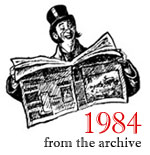Anti-Abortion Atheist Doctor

The Abortion Papers: Inside the Abortion Mentality
By Bernard N. Nathanson, M.D.
Publisher: Frederick Fell Publishers
Pages: 240
Price: $14.95
Review Author: Francis Canavan
Dr. Nathanson should have made headlines in 1979 with his book Aborting America. He had been, after all, the only physician among the founders of the pro-abortion National Association for Repeal of Abortion Laws and the director of the world’s largest abortion clinic and by 1979 he had developed serious doubts about the morality of abortion. But, in fact, his book was given the silent treatment by the press and kept under the counter by the bookstores. Yet it was, as he now describes it, “a restrained and dispassionate treatment of a notoriously combustible subject.” Its only “fault” was that it raised troubling questions about the premises of abortion on demand.
Dr. Nathanson recently gave a talk at Fordham University in which he called the present work under review here, in contrast, “an angry, passionate advocacy book” and “decidedly partisan.” In the book itself he refers to “permissive abortion” as a “crime” and “an unmitigated evil,” and speaks of “the inexpressible horror of the abortion madness.” His horror and anger spring from the conviction at which he has now arrived: that from the moment of conception an unborn child is “a living, valuable, and fully protectible human being.”
He has come to this conclusion through his close involvement, as an obstetrician and gynecologist, in the new “science of fetology.” It is only in the past decade, or a little more, that new medical technology has enabled physicians to observe visually the development of the fetus in the womb. As late as the 1960s, says Nathanson, “to believe that there was something demonstrably human in the uterus at the fourth, sixth, or eighth week of pregnancy was quite simply an act of faith: You couldn’t see it, you couldn’t hear it, and therefore you couldn’t really know it.” Now, with such devices as real-time ultrasound and fetoscopy, we can see what is growing in the womb and recognize that it is, without qualification, a human baby.
It takes a remarkably unphilosophical mind to think that being human consists in looking human. But unphilosophical minds are what many Americans have, especially among the opinion making elites.
Nathanson has transcended sensism, but it was the rapidly accumulating scientific evidence that convinced him that from a very early period in a pregnancy we are dealing with a living, moving, even breathing child that has a beating heart and emits brainwaves. In the face of this evidence, he abandoned the notion that human life begins at birth, or that “prenatality” is anything other than the first stage in the unbroken continuum of human life. The living being in the womb, he now says, is a “prenatal person.”
Since this is so, he argues, the foundations of the U.S. Supreme Court decision which made abortion a constitutional right and the unborn child a nonperson have crumbled. For Nathanson, doctors should now regard the prenatal person as his patient, not his victim, and the courts should recognize this person as the subject of a right to life equal to any other person’s.
Nathanson appears to believe that the weight of the evidence will eventually force the Supreme Court to reverse itself on abortion. Yet he well knows the forces he is up against. Prove to the hilt that the unborn child is a fully human being, and the answer of a substantial number of influential people will be, “So what?” These people have moved beyond denying the humanity of the fetus to questioning the value of human life at any stage if it suffers the misfortune of being “unwanted” or “not meaningful.”
The part of this book devoted to fetology constitutes its second part. The first part documents in illuminating detail the way in which the abortion controversy has been reported by “the mega-press: the all-powerful eastern liberal newspapers such as the New York Times and the Washington Post, the three television networks, the wire services of the Associated Press and the United Press International, and the news magazines such as Time and Newsweek.” To which list add the “powerful, trendy, wealthy, imperial (it goes to 130 countries)” New England Journal of Medicine. Reporting on the abortion issue in the mega-press, Nathanson charges, “has been partisan, prejudiced, and consistently favorable to…pro-abortion forces.”
The third part of the book once again tells the story of how, originally, Nathanson and the other leaders of the National Association for Repeal of Abortion Laws deliberately appealed to anti-Catholic prejudice in order to win their pro-abortion objective. In retrospect, Nathanson doubts if “the Catholic card” had to be played in order to win, and he is ashamed of his part in playing it. It was, nonetheless, a brilliant political tactic to portray the Roman Catholic Church as the only opponent of abortion. “The more vigorously the church opposed, the stronger the appeal of the anti-Catholic line” became to the mega-press and other pro-abortion forces.
Bernard Nathanson still calls himself an atheist, but he has a passionate conviction about the worth of human life that should put certain professed Christians — including Catholics — to shame.
©1984 New Oxford Review. All Rights Reserved.
You May Also Enjoy
The prolife movement of the 21st century must adopt chastity as the fifth pillar of advocacy for preborn children.
He refers to God as Mother, encourages homosexual advocacy, denies the spiritual reality of Original Sin, and denies the necessity of the Cross for redemption.
If there is universal salvation, then abortion is not an "abominable crime" -- God automatically forgives everything.

